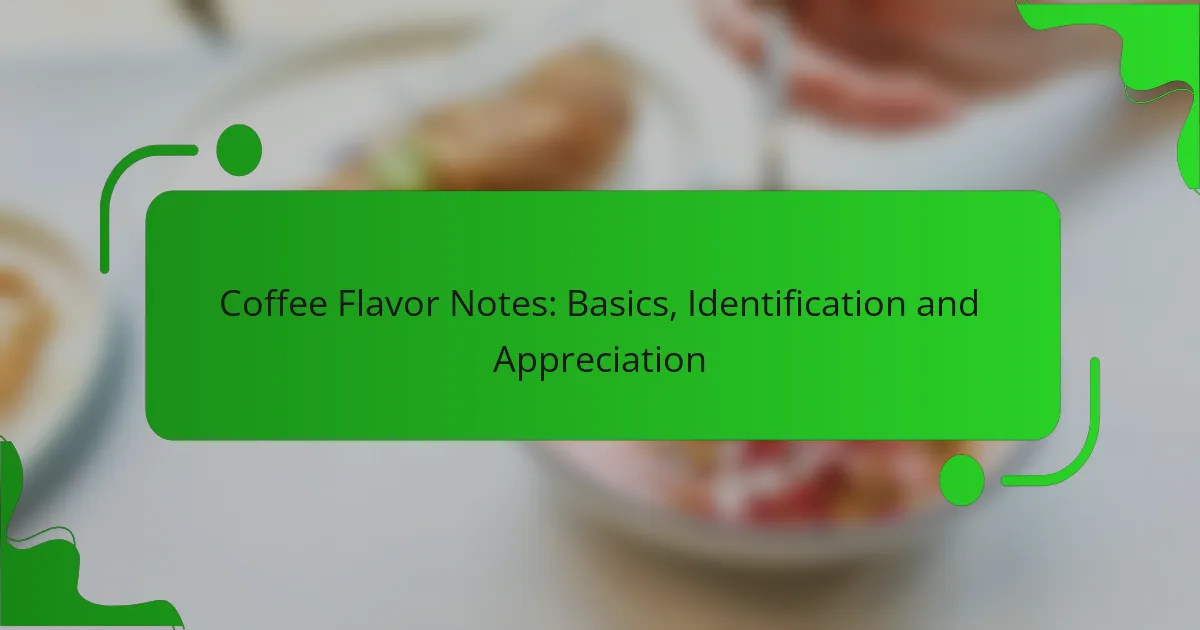The Coffee Flavor Wheel is an essential tool for coffee lovers, enabling them to identify and describe the wide range of flavors present in coffee. By mastering its categories, users can refine their tasting skills, enhance their brewing techniques, and make more informed coffee selections. This resource not only enriches individual coffee experiences but also cultivates a shared language within the coffee community, fostering a deeper appreciation for this beloved beverage.

How to use the Coffee Flavor Wheel effectively?
The Coffee Flavor Wheel is a tool designed to help coffee enthusiasts identify and articulate the diverse flavors found in coffee. By understanding its structure and categories, users can enhance their tasting skills and make informed choices about coffee selections.
Identifying flavor profiles
To identify flavor profiles using the Coffee Flavor Wheel, start by familiarizing yourself with its various categories, such as fruity, floral, and nutty. As you taste different coffees, refer to the wheel to pinpoint specific flavors that resonate with your palate.
For example, if you detect a berry-like taste in your coffee, you can look at the wheel to find related descriptors, such as “blueberry” or “raspberry.” This practice not only sharpens your tasting skills but also enriches your overall coffee experience.
Enhancing coffee tasting experiences
The Coffee Flavor Wheel enhances tasting experiences by providing a structured way to explore and compare flavors. When tasting coffee, take notes on the flavors you perceive and use the wheel to categorize them, which can deepen your appreciation of different brews.
Consider hosting a coffee tasting session with friends, where each participant uses the wheel to describe their findings. This interactive approach fosters discussion and can lead to discovering new flavor nuances that you might have missed on your own.
Guiding coffee selection
Using the Coffee Flavor Wheel can significantly guide your coffee selection process. When purchasing coffee, refer to the wheel to match your flavor preferences with the coffee’s profile. For instance, if you enjoy bright, citrusy flavors, look for coffees labeled with descriptors like “lemon” or “orange” on the packaging.
Additionally, many specialty coffee roasters include flavor notes on their bags that correspond with the wheel. This can help you make informed choices, ensuring that you select coffees that align with your taste preferences, whether you’re shopping online or at a local café.

What are the benefits of using the Coffee Flavor Wheel?
The Coffee Flavor Wheel offers several benefits, including enhanced flavor recognition, improved brewing techniques, and better coffee pairings. By utilizing this tool, coffee enthusiasts can deepen their appreciation and understanding of various coffee profiles.
Improved flavor recognition
The Coffee Flavor Wheel helps users identify and articulate specific flavors present in their coffee. By categorizing flavors into distinct groups, it allows for a more nuanced tasting experience, making it easier to pinpoint notes like fruity, nutty, or floral.
When tasting coffee, refer to the wheel to match your sensory experiences with the corresponding flavor categories. This practice can significantly enhance your ability to recognize and describe flavors, leading to a more enjoyable coffee experience.
Enhanced brewing techniques
Understanding the flavor profiles on the Coffee Flavor Wheel can guide you in selecting appropriate brewing methods. Different coffee beans may require specific brewing techniques to highlight their unique flavors, such as using a French press for bold, full-bodied coffees or pour-over for lighter, more delicate brews.
Experimenting with various brewing times and temperatures based on the flavor characteristics can yield better results. For instance, a coffee with bright acidity may benefit from a shorter extraction time to maintain its vibrant notes.
Better coffee pairings
The Coffee Flavor Wheel can assist in pairing coffee with food by suggesting complementary flavors. For example, a coffee with chocolate notes pairs well with desserts like brownies, while fruity coffees can enhance breakfast items like pancakes or fruit salads.
When considering pairings, look for flavors that either contrast or complement each other. This approach can elevate both the coffee and the food, creating a harmonious tasting experience that highlights the best attributes of each.

How does the Coffee Flavor Wheel influence local coffee culture?
The Coffee Flavor Wheel significantly shapes local coffee culture by providing a common language for tasting and appreciating coffee. It helps consumers and baristas alike identify and articulate the diverse flavors found in different coffee beans, fostering a deeper connection to the beverage.
Promoting specialty coffee shops
The Coffee Flavor Wheel encourages the growth of specialty coffee shops by highlighting unique flavor profiles that differentiate their offerings. These shops often curate their selections based on the wheel, allowing customers to explore various tastes and aromas, which can enhance their overall coffee experience.
By using the flavor wheel, specialty coffee shops can create targeted marketing campaigns that attract coffee enthusiasts looking for specific flavor notes, such as fruity or nutty. This focus on flavor diversity can lead to increased customer loyalty and higher sales.
Encouraging local coffee tastings
Local coffee tastings are often organized around the Coffee Flavor Wheel, providing an interactive way for participants to learn about and experience different coffee varieties. These events can help build community among coffee lovers and educate them on how to identify flavors using the wheel.
During tastings, participants can compare different coffees side by side, using the flavor wheel as a guide to articulate their preferences. This not only enhances their tasting skills but also encourages them to explore local roasters and specialty shops that offer unique blends and single-origin coffees.

What are the key components of the Coffee Flavor Wheel?
The Coffee Flavor Wheel is a visual tool that categorizes and describes the various flavors and aromas found in coffee. It helps coffee enthusiasts and professionals identify and articulate the sensory characteristics of different coffee beans.
Flavor categories
The Coffee Flavor Wheel is divided into several primary flavor categories, including fruity, floral, nutty, and spicy. Each category encompasses a range of specific flavors that can be detected in coffee, allowing for a nuanced tasting experience.
For example, the fruity category may include flavors like berry, citrus, or stone fruit, while the floral category might feature jasmine or rose. Understanding these categories helps tasters pinpoint the overall profile of a coffee.
Descriptive terms
Descriptive terms on the Coffee Flavor Wheel provide a vocabulary for articulating specific tastes and aromas. These terms can range from basic descriptors like sweet or bitter to more complex ones like caramelized or earthy.
Using these terms effectively can enhance coffee tasting sessions by allowing participants to share their impressions clearly. For instance, describing a coffee as having a “chocolaty” flavor can evoke a specific sensory experience, making it easier to compare different coffees.

How can I develop my coffee tasting skills?
To develop your coffee tasting skills, immerse yourself in the flavors and aromas of various coffee types. Regular practice and exposure to different beans will enhance your palate and understanding of coffee nuances.
Practice with different coffee beans
Experimenting with a variety of coffee beans is essential for honing your tasting skills. Try beans from different regions, such as Ethiopian, Colombian, or Brazilian, as each offers unique flavor profiles. Focus on single-origin coffees to better identify specific tasting notes.
When tasting, pay attention to the aroma, acidity, body, and aftertaste. Use a coffee flavor wheel to help categorize and describe what you experience. This tool can guide you in identifying flavors like fruity, nutty, or chocolatey.
Join local coffee tasting events
Participating in local coffee tasting events can significantly enhance your skills. These gatherings often feature expert baristas and roasters who can provide insights into brewing techniques and flavor identification. Look for events at local cafes or specialty coffee shops.
Networking with fellow coffee enthusiasts can also deepen your understanding. Sharing experiences and tasting notes with others can expose you to new perspectives and flavor combinations you might not have considered before.

What are common mistakes in coffee tasting?
Common mistakes in coffee tasting include neglecting important sensory elements and not considering the impact of brewing methods. These oversights can lead to a skewed perception of the coffee’s true flavor profile.
Ignoring aroma
Aroma plays a crucial role in coffee tasting, as it significantly influences flavor perception. Many tasters focus solely on taste, missing out on the complex scents that contribute to the overall experience.
To enhance your tasting, take a moment to inhale the aroma before sipping. Look for specific notes such as floral, fruity, or nutty scents, which can provide insight into the coffee’s origin and processing methods.
Overlooking brewing methods
The brewing method can dramatically affect the flavor and aroma of coffee. Different techniques, such as pour-over, French press, or espresso, extract flavors differently, leading to varied tasting experiences.
Experiment with various brewing methods to discover how they influence the coffee’s profile. For instance, a French press may yield a fuller body, while a pour-over might highlight acidity and clarity. Understanding these differences will enhance your overall tasting skills.

How to pair coffee with food using the Flavor Wheel?
Pairing coffee with food using the Flavor Wheel involves understanding the flavor profiles of both the coffee and the dish. By identifying complementary flavors, you can enhance the overall tasting experience and create harmonious combinations.
Complementary flavor profiles
Complementary flavor profiles are those that enhance each other when paired together. For coffee, this means selecting beans with flavor notes that align with the characteristics of the food. For example, a fruity coffee can pair well with desserts that feature berries or citrus.
Consider the basic flavor categories: sweet, sour, salty, bitter, and umami. A sweet coffee can balance out a salty dish, while a bitter coffee might complement rich, fatty foods. Experimenting with these profiles can lead to delightful discoveries.
Some classic pairings include a chocolatey coffee with dark chocolate desserts or a nutty coffee with roasted nuts. Keep in mind that personal preference plays a significant role, so tasting different combinations can help you find your ideal match.



